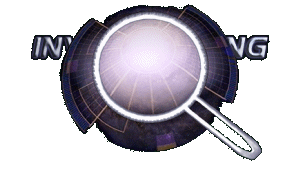
|
Astronomy |
Overview
This chapter examines various real
astronomical problems occurring on Star Trek, as well as inconsistencies regarding the
geography of the Star Trek galaxy. It has to be clarified:
Why a quadrant
is not always a quarter of the Milky Way
Problem: In the original Star Trek series, the both measures "sector"
and "quadrant" are used contradictory. Both mean a spatial volume that is
considerably smaller than the Galaxy, but also fundamentally larger than a single
planetary system. Although "quadrant" literally refers to a "quarter"
and therefore should be logically used for naming a quarter of the Milky Way, it usually
refers to a smaller, sector-sized area of space, e.g. "quadrant 904" in [TOS]
The Squire of Gothos. Since Star Trek VI, that means the late 23rd century, commonly a
new, more correct quadrant system is used, according to which "the Galaxy is
subdivided into 4 quadrants, from which each forms a 90 degrees piece of cake, viewing the
Galaxy from the top or the bottom" (Star Trek Encyclopedia). However, the assumption
that solely this system is used seems to be wrong, since some Next Generation episode use
the term "quadrant" like TOS as a sector-sized region (e.g. the "Morgana
quadrant" in [TNG] The Child and Where Silence Has Lease).
Reasons: It is simple to explain why the
"quadrant" was originally used contradictory - at that time, the measures sector
as well as the quadrant weren't fixed at all und were used at will by the authors. They
were determined a long time after TOS, in case of the sector not before 1994, when the
Star Trek Encyclopedia was published. While there hasn't been an on screen definition of
the sector up to now, the quadrant was defined for the first time already in 1979 for the
unofficial "Star Trek Maps". To scale the poster-sized maps of this project, the
Galaxy was divided into nine quadrants: quadrant 0 at the galactic core and four quadrants
North and South*. This subdivision of
three-dimensional space called "octant system" in mathematics more logical in
that respect that the Milky Way isn't a flat two-dimensional disc, but has a thickness of
5000 ly on average, with Earth being located 50 ly above the thought central dividing
plane, the so-called "Galactic plane". However, the system, as the maps
themselves, was never acknowledged by official sources nor regarded as "canon".
Believing the background sources, on the other hand, the quadrant system used in the new
series and the feature films and the distinction between the densely populated Alpha
Quadrant and the mainly unexplored Beta Quadrant was originally introduced to justify
Kirks remark in Star Trek II (premiere date: 1984) that the Enterprise is the sole
starship in the quadrant - even though this doesn't make this quote more credible (since
with Vulcan, Antares and Rigel, three important main planets of the Federation are located
in the Beta Quadrant). In Star Trek VI, this system was extensively used for the first
time, and the position of the large powers in the single quadrants was determined
(Klingons and Romulans in Beta Quadrant, Federation in Alpha Quadrant). Already before the
premiere in 1991, the new quadrant system was introduced for Star Trek: The Next
Generation with the episode [TNG] Der Barzanhandel, that aired in 1989. Therefore it
is logical that some TNG episode of the first and second seasons use the
"quadrant" differently, even though they play a long time after Star Trek VI.
Potential explanation: In the early and middle 23rd century, the
term "quadrant" was used parallel to the "sector", i.e. it referred to
a smaller area of space with a certain diameter. In the 2280s, a quadrant system was
introduced that is valid up to now. This system divides the Galaxy into four equally
sized, cubic quadrants. While most of the old quadrants were newly numbered as sectors,
some quadrant designations were kept as proper names for historical reasons, even though
they actually contradict with the common quadrant system. Therefore, there are even in the
24th century quadrants that do not carry the designations Alpha, Beta, Gamma or Delta.
Additional note: Read more about quadrants and sectors in
chapter 2.2 of the Star Trek Cartography "The
subdivision of the Star Trek Galaxy".
Why the
arrangement of the quadrants led to some confusion
Problem: The designations of the quadrants and their sizes
are commonly accepted and uniform to a large extent at the latest since [TNG] The Price,
where the Alpha, Gamma and Delta Quadrant were introduced, and Star Trek VI, which
mentioned the Beta Quadrant for the first time. On the other hand, the actual subdivision
of the Galaxy into quadrants led to some problems. The first edition of the official Star
Trek Encyclopedia, published in 1994, clarified that the Galaxy is divided into four
quadrants from which each forms a 90 degrees piece of cake, viewing the Galaxy from the
top or the bottom. Beside this description, a chart illustrated the arrangement of the
single quadrants, which was also re-used for the second and third edition of the Star Trek
Encyclopedia, as well as the Star Trek: Deep Space Nine Technical Manual, how the following picture from the
Encyclopedia II shows:
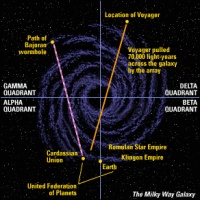
According to this, the
quadrants are arranged fairly illogically, neither clockwise nor counter-clockwise: the
lower left quadrant is called "Alpha", the lower right one "Beta", the
upper left one "Gamma" and the upper right one "Delta". However, the
final arrangement of the quadrants was unimportant, since (labelled) charts of the Galaxy
were never used in Star Trek: The Next Generation or in Star Trek: Deep Space Nine. Apart
from the fact that according to the development in Star Trek VI Alpha Quadrant and Beta
Quadrant must be adjoining regions of space (what is natural in view of the designations),
the spatial situation did never play a role for the plot anyway. Therefore, the system was
accepted by the fans without difficulty and declared "canon" - until Star Trek:
Voyager aired. The new series dealt with the journey of the USS Voyager, which has been
stranded deep in the Delta Quadrant, back home to the Alpha Quadrant - what seems
logically if Earth is located exactly on the borderline between two quadrants.
Consequently, according to the official arrangement of the quadrants, Voyager would not
only have to cross the Delta Quadrant, but also the entire Beta Quadrant, before she
reaches Earth. Surprisingly, this fact was never mentioned on screen. Instead, the Beta
Quadrant was hushed up and virtually banished from the "Voyager" Galaxy.
Although it plays an elementary role with regards to the sphere of influence of the Borg
and the Romulan and Klingon empires, and therefore should be mentioned in the series,
there are not more than two reference in 145 episodes: in [VOY] Before and After ("like
the Yattho from the Beta Quadrant, who can predict the future [...]") and in
[VOY] Timeless ("Starfleet found a Borg cube wreckage in the Beta Quadrant"),
with the first quote being rather trivial. Moreover, there are increasingly references
regarding the Alpha Quadrant which should actually concern the Beta Quadant, like in [VOY]
Barge of the Dead ("The simplest explanation is that the Borg assimilated a Bird of
Prey somewhere in the Alpha Quadrant" - not likely the simplest explanation).
Although in the sixth season, Voyager is only a few thousand light years away from the
border of the Delta Quadrant, there wasn't any reference to the new quadrant in the entire
season. These clues corroborate the impression that Voyager does not need to cross the
Beta Quadrant at all to reach Earth, and consequently the Alpha and Beta quadrants must
be swapped. This assumption is apparently confirmed by [VOY] Message in a Bottle,
because it was shown in this episode, what was only implied before: according to several
references in the dialogue, the USS Prometheus was located in the Alpha Quadrant, but the
map shown in the Astrometric Lab definitely marked its position in the lower right
quadrant. The farthest station of the alien relay network is situated there as well, that
spreads up to the "deep Alpha Quadrant" according to the episode.
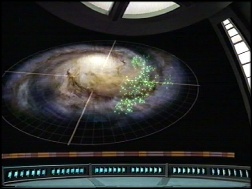
|
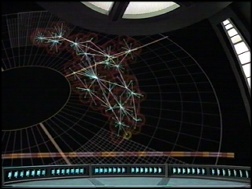
|
Therefore, many fans
accept a counter-clockwise quadrant system with this "on screen evidence",
justifying this decision with the generally accepted rule that facts introduced in
official documentations are only "canon" as long as they don't contradict with
the episodes and feature films. And indeed, the official quadrant system introduced in
1994 was never shown on screen - neither in Star Trek: The Next Generation nor in Star
Trek: Deep Space Nine.
Reasons: As Rich Sternbach has indicated*,
the writers try to avoid to mention the
Beta Quadrant as far as possible simply because they think this would confuse casual
viewers, who only know that the crew of Voyager has stranded in the Delta Quadrant and now
wants to get back to the Alpha Quadrant, since that is the region where Earth is located.
The surely know that Voyager is very near to border, however, according to the series'
premise they like to remain Voyager in the Delta Quadrant until it finally finds a way
back to Earth, what certainly does not happen before the second half of the seventh
season. Consequently, detours and astronomical obstacles are cited as reasons why Voyager
still hasn't reached the Beta Quadrant. Of course, this lack of references concerning the
Beta Quadrant has finally created the situation that at least those fans who are familiar
with the Encyclopedia are fairly confused regarding the quadrant system.
Explanation: In the end, the answer of the question what quadrant system is correct
after all is quite simple: in the 6th season, the official quadrant system from the
Star Trek Encyclopedia was shown on screen for the first time and therefore established as
fully canon. Probably, we owe the appearance of the (correctly) labeled Milky Way map in
the Starfleet Communications Center in San Francisco the people working at the Star Trek
Art Department, not the authors of the episode [VOY] The Pathfinder Project - perhaps even
as a reaction of the postings of many confused fans in various newsgroups and forums.
Anyway, this map is much more definite than the (non-labeled) charts and indirect
statements in [VOY] Message in the Bottle, so that we can forgot these embarrassing
errors.
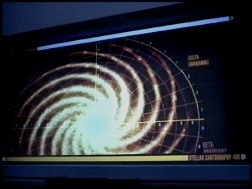
|
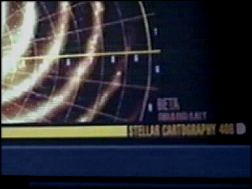
|
However, what -
according to the statements of the crew - the empires of Klingons and Romulans, the home
planet of the Vulcans and the farthest outposts of the Borg have familiar with the Alpha
Quadrant, seems to be a different question ...
Additional note: Read more about the quadrants in chapter 2.2
of the Star Trek Cartography "The subdivision
of the Star Trek Galaxy".
What real star
Vulcan orbits
Problem:
During the 35 years covering history of Star Trek, the starships of Starfleet - the
Enterprise, the Voyager, the Defiant and many more - have visited hundreds of planets.
Thirty-seven of those planets orbit real stars of our Milky Way, e.g. Rigel IX, Antares IV
and Tau Ceti Prime, so that we can exactly determine their situation relative to Earth in
the meantime. Most positions, however, remained unknown, what isn't necessarily a bad
thing regarding worlds which only played a role once in one episode. But - a frequently
raised but rarely answered question of the fans is the query what star the probably most
famous fictitious Star Trek planet orbits; those extra-solar world with which Earth made
first contact on April 5th, 2063: Vulcan.
Reasons: Although the home planet of the Vulcans,
like its inhabitants, is one of the most important and popular elements of the Star Trek
universe and the setting of numerous episodes, the name of its system and therefore its
position remained a mystery during the original Star Trek series. Sadly, the feature films
and the later Star Trek series continued this tradition, and the Star Trek Encyclopedia as
well as all other official documentations ignored the issue.
Explanation: Due to the lack of an on screen quote or at
least an official statement concerning the real star that Vulcan orbits is canonically
unknown, and we can only make assumptions, analysing the properties of known
real stars.
At least, the episodes
and movies, especially the legendary episode [TOS] Amok Time, provide some clues, limiting
the number of potential stars:
The star is located
in the immediate neighborhood of the Sun.
The dominance of Starfleet Command in
[TOS] Amok Time (e.g. no time delay of the communication) already implies an Earth-near
position. But Star Trek: First Contact and the official Star Trek history make a farther
distance from our star unlikely as well - otherwise, Vulcans wouldn't have been the first
aliens that had contact with the human kind.
The star is located
near the real star Altair, consequently being only one or two dozen light years away from
Earth.
The distance of Vulcan from
Earth can be determined even more precisely with the help of [TOS] Amok Time. The
Enterprise travels, from an unknown starting point, to Altair IV, making a
(inconsiderable) detour to Vulcan. Because the mission is very time-critical and only
covers a few days, the distance between Altair and Vulcan must be relatively small.
The Vulcan sun is an
orange-yellow star.
When we saw Vulcan for the
first time in [TOS] Amok Time, it was a reddish, hot world. Although this basic
characteristic was always retained, the properties of the Vulcan sun can only be estimated
since the more differentiated presentation of the planetary surface in the Star Trek
movies. Based on the orange light that shone on Spock during his Kohlinar in Star Trek:
The Motion Picture and the shades of orange of the mountains around Mount Seleya in Star
Trek III and IV, we can assume that Vulcan's sun is orange as well. It would then belong
to a different spectral class than our yellow sun (type G2) - either a high G class or a
low K class, while the luminosity class would be essentially the same (V). However, this
is a quite uncertain clue, since firstly, such details were rarely paid attention to
regarding the presentation of planetary surfaces (especially in view of the different
appearances of Vulcan in the various movies and series) and secondly, an analysis of the
color of a star based on the mere lighting conditions on a planet can be very deceptive;
only remember the orange-reddish color of the Martian sky caused by iron-oxide dust.
Based on the first
two, cogent clues we can still track down numerous stars in the neighborhood of the Sun.
Yet, very early - even before the premiere of the first feature films at the beginning of
the 1980s - two candidates had been chosen, since the fandom and some Star Trek
enthusiastic astronomers had dealt with the issue. The (unofficial) books "Star Trek
2" (published in 1968, by James Blish), "Starfleet Technical Manual"
(published in 1974, by Franz Joseph) and "Star Trek Maps" (published in 1979, by
Jeff Maynard, Geoffrey Mandel and others) mention the real star 40 Eridani (aka � Eridani) as the Vulcan sun, while
the "Star Trek Spaceflight Chronology (published in 1980, by Stan and Fred Goldstein)
list Epsilon Eridani. However, it isn't the case that we have
two equally suitable, but completely uncanon candidates for Vulcan's sun. Indeed, on the
occasion of the 25th anniversary of Star Trek, Gene Roddenberry himself, together with
three scientists of the Harvard-Smithsonian Center of Astrophysics, has examined the stars
in question and named one as the most likely candidate. The results were published in a
short letter in the specialist journal Sky & Telescope in July 1991. The following text
is an excerpt from the main part of the article*:
We prefer the identification of 40 Eridani as Vulcan's sun
because of what we have learned about both stars at Mount Wilson. The HK Project takes its
name from the violet H and K lines of calcium, both sensitive tracers of stellar
magnetism. It turns out that the average level of magnetic activity inferred from the H
and K absorptions relates to a star's age; young stars tend to be more active than old
ones (Sky & Telescope: December 1990, page 589). The HK observations suggest that 40
Eridani is 4 billion years old, about the same age as the Sun. In contrast, Epsilon
Eridani is barely 1 billion years old.
Based on the history of life on Earth, life on any planet around
Epsilon Eridani would not have had time to evolve beyond the level of bacteria. On the
other hand, an intelligent civilization could have evolved over the aeons on a planet
circling 40 Eridani. So the latter is the more likely Vulcan sun.
In that case, Mr Spock's daytime star is a 4.4-magnitude multiple
system about 16 light-years from Earth. Presumably Vulcan orbits the primary star, an
orange main-sequence dwarf of spectral type K1. Data from the HK Project reveal that it
has a starspot cycle of roughly 11 years, just like the Sun. [Diagram here of 40 Eridani's
starspot cycle, showing that the latest peak in starspot activity was in 1989.]
Two companion stars--a 9th-magnitude white dwarf and an
11th-magnitude red dwarf--orbit each other about 400 astronomical units from the primary.
They would gleam brilliantly in the Vulcan sky with apparent magnitudes -8 and -6,
respectively.
SALLIE BALIUNAS
ROBERT DONAHUE
GEORGE NASSIOPOULOS
Harvard-Smithsonian Center for Astrophysics
Cambridge, MA
GENE RODDENBERRY
Paramount Pictures Corp.
Los Angeles, CA
Consequently, 40 Eridani is our candidate. However, it has to be
considered to what extent this fact can be called "canon" or
"official", even if it has already been cited in countless fandom projects
(while it remains unknown who was the first to have this idea). But it is a fact that in
the same year, albeit some months before the publication of the article (on March 18th,
1991), the episode [TNG] Night Terrors aired, containing an in-joke regarding
40
Eridani-A, the main component of the trinary system 40 Eridani and therefore making at
least the star itself a part of the official Star Trek universe, even if there isn't a
reference to Vulcan: the dedication plaque of the USS Brattain identified the ship as
"Miranda class, constructed at 40 Eridani-A Starfleet yards". This plaque can be
seen in all editions of the Star Trek Encyclopedia, while again there isn't a note
regarding the significance of 40 Eridani below this and the "Vulcan" entry.
However, the article in Sky & Telescope is sufficiently crucial. In the end, a letter
that carries Gene Roddenberry's signature can't be less canon then the
"official" documentations of other highly ranked Star Trek employees like
Michael Okuda or Rick Sternbach. Just as we treat the Star Trek Encylopedia
and the
technical manuals, we should proceed here: as long as we hear or see nothing
contradictious in the series or feature films, 40 Eridani officially and canonically is Vulcan's sun.
Additional note: The positions and basic properties of 40 Eridani - as well as
the other real stars of Star Trek - are listed in the Star
Trek Cartography table "The
positions of the real stars".
Credits
Thanks to Geoffrey
Mandel, co-author of the Star Trek Maps, for the description of the quadrant system.
Thanks to Geoffrey
Mandel and Rick Sternbach himself for shedding some light on the Beta Quadrant issue.
Thanks to Brent Davies, who was the first to track down
the letter concerning Vulcan's sun and who has further examined the properties of this
star, and Winchell Chung, who has published the
complete article - together with many other exciting topics - on his website. More credits for the
makers of the interactive Star Trek: The Next Generation CD-ROM, which contains background
information on [TNG] Night Terrors, as well as Bernd
Schneider, who pointed the temporal correspondence of Gene Roddenberry's letter and
the episode.
|